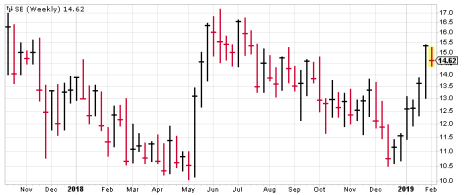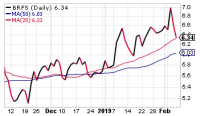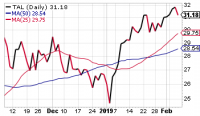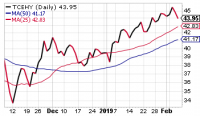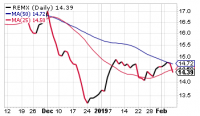Emerging market stocks remain in an uptrend, though like most stocks around the globe, a little resting wouldn’t be uncalled for after the recent run-up. Even so, with our Emerging Markets Timer still green, we’re looking to add exposure at opportune times.
Tonight, I see two opportunities—one from the less-followed area of Southeast Asia, and one from China, as one of our watch list stocks is being upgraded to buy. Many of our recommendations are making solid progress, and I’m optimistic both of these can be leaders going forward.
Cabot Emerging Markets Investor 678
[premium_html_toc post_id="170364"]
Cabot Emerging Markets Timer
The Emerging Markets Timer is our disciplined method for staying on the right side of the emerging markets. The Timer is bullish when the index is above the lower of its two moving averages and that moving average is trending up.
Our Emerging Markets Timer remains clearly positive, having shot persistently higher since the calendar flipped. You can see that the iShares EM Fund (EEM) has pushed from around 39 at the start of the year to 42 today (about a 10% move) in basically a straight line, pulling well ahead of its lower (now 50-day line). And that means the intermediate-term trend remains firmly up.
Of course, after a good run and with some resistance in this area (43 to 44, as you can see in the chart), a pause or shakeout is certainly possible. But with the EM Timer positive, you should be putting money to work and treating normal pullbacks as opportunities to add exposure.
Still Positive, but Lots of Moving Parts
Our Emerging Markets timer remains positive, which is keeping me in the mode of putting some money back to work. We need to remain a bit cautious—today’s sharp retreat is a clear sign there are still plenty of jitters to work though—but in tonight’s issue we have a new recommendations, and give some space to watch list stock that we’re upgrading to buy.
On the economic front, while the Federal Reserve once talked about hiking the key interest rate two more times in 2019, most market participants aren’t betting on that any more—futures markets are basically pricing in no rate hikes for the entire year.
The main reason for the change in tune was the stock market plunge in December (which, if you remember, came on the heels of the Fed’s last rate hike) and a handful of weaker-than-expected economic reports so far this year. One unintended consequence of a looser Fed policy could be a weaker U.S. dollar this year, though so far, that hasn’t happened.
A weaker greenback is almost always a positive for emerging markets, and I think this could be an added catalyst for EM stocks to outperform their U.S. peers this year.
As for the soap opera that is U.S.-China trade negotiations, U.S. Trade Representative Robert Lighthizer and Treasury Secretary Steven Mnuchin will head to China next week to continue trade talks. That said, there were a couple of bad headlines today—one that said there’s a ways to go before any deal is struck, with another saying President Trump and Xi are unlikely to meet before the March 1 tariff deadline—that weren’t well received by the market.
No matter what happens, we’ll continue to take our cues from the market and our stocks. Interestingly, even after a nice move, the 800 companies in the iShares EM Fund are still relatively cheap relative to the S&P 500.On a forward price to earnings basis, they trade at a 32% discount, on price to book basis, the discount is 49%, and on price to sales, the discount is a 44%.
Add all these factors up and there are plenty of reasons to think the uptrend in EM stocks (and their recent outperformance) can continue.
The Sweetspot of Asia
Only three times the size of Washington, D.C., and the busiest port in Asia, Singapore is situated next to the vital trading channel of the Straits of Malacca, the gateway for 37% of global shipping and 80% of China’s oil imports.
Singapore’s annual trade volumes are a stunning four times the size of its economy and it’s one of only seven countries in the world to enjoy an AAA credit rating. Surprisingly, some firms are moving manufacturing centers from China to high-cost Singapore due to its infrastructure, logistics and laws protecting intellectual property.
Singapore is also a good proxy for many investors as its companies invest heavily and pursue business in neighboring countries.
While China and India dominate headlines, the strategic importance and investment opportunities presented by Southeast Asia are far greater than currently recognized by investors.
The 10 member countries of the Association of South East Asian Nations (ASEAN) have a combined population of 645 million and a GDP approaching $3 trillion - larger than India’s GDP. These members include Indonesia, Thailand, Vietnam, Philippines, Malaysia, and Singapore and their combined economies have grown 170% over the past decade with a 6.5% average growth rate.
One more surprising stat; over the past several years Southeast Asia received more foreign direct investment than China. It’s this area that is the main driver for our new recommendation in today’s issue.
Featured Stock
New Recommendation: Sea Limited (SE)
E-Commerce in Southeast Asia
Sea Limited was founded in 2009 under the name Garena and went public in October 2017. It’s a Singapore company that provides digital entertainment, e-commerce and financial services in Southeast Asia.
Specifically, it provides a digital entertainment platform for users that allows them to access mobile and PC online games, eSports operations and other entertainment content, such as live streaming of online game play and social features. Sea Limited also operates the Shopee e-commerce platform, a third-party marketplace that connects buyers and sellers through the Shopee mobile app and Websites.
And the company also offers digital financial services to individuals and businesses, including e-wallet and payment services through the AirPay mobile app and AirPay counter applications on mobile phones or desktops; payment processing services for Shopee; and a payment-processing platform for prepaid cards.
Importantly, Sea is backed by China’s Tencent Holdings through both an equity investment and a distribution agreement under which Tencent grants Sea right of first refusal to publish Tencent’s mobile and PC games in Indonesia, Taiwan, Thailand, the Philippines, Malaysia and Singapore.
While it’s still unprofitable and should remain so for another couple of years, Sea has been growing its top line rapidly and its stock is in a strong uptrend as investors look for ways to access the youthful, tech-savvy markets in Southeast Asia. Forrester estimates that the e-commerce market of young shoppers in the region will grow by more than 400% in the next seven years! So there’s plenty of growth potential for Sea.
In the third quarter, revenue grew 118% from the prior year, thanks mainly to booming e-commerce growth—gross merchandise volume lifted 153%, orders were up 141% and adjusted revenues exploded. In Indonesia, Shopee’s largest market, total orders for the last reported quarter reached 63.7 million, or a daily average of 0.7 million orders, which makes Shopee the largest e-commerce platform in Indonesia.
For the full year 2018, management sees total revenues up more than 70%, with gross merchandise volume up 130%. The next quarterly report is likely out within two or three weeks, though there’s no set release date yet.
The company reports that its self-developed game, Free Fire, is now one of the world’s most popular online games, recently achieving its record high peak daily active user count of over 27 million and surpassing 200 million registered users globally.
SE started trading back in October 2017 and promptly plunged from 17 to 10 by May of last year, before rallying back to 17. Then came another prolonged dip to 10.5 in December! But the action since then is excellent, with a quick ramp as high as 15 on four straight weeks of heavy volume, before the recent dip. We’re adding it to our portfolio tomorrow. BUY.
Sea Limited (SE)
1 Fusionopolis Place
No. 17-10, Galaxis
Singapore 138522
Singapore
http://www.seagroup.com
RECOMMENDED MOVE FROM WATCH LIST TO BUY
Nio (NIO) is a $7.9 billion Shanghai-based electric vehicle company.
Nio was up 24% in January on news of beating delivery guidance and plans for a $650 million offering of convertible senior notes due 2024 that closed this week. The company was founded just four years ago and pulled off a U.S. initial public offering in September, three months after starting deliveries of its first electric model, the ES8 sport utility vehicle.
Currently, the ES8 is this Chinese automaker’s only mass-production automobile—it’s an SUV similar to Tesla’s Model X. Nio launched the ES8 in December 2017 and began deliveries on June 28, 2018.
In December of last year, NIO launched its second electric SUV, the ES6, during its NIO Day 2018 event. The ES6 comes with a lower price tag than the ES8, and it’s a five-seat SUV compared to the seven-seat ES8. The company claims that the ES6 base model can deliver up to 410 km (255 miles) and the high-end variant can deliver up to 510 km (317 miles) of range in a single charge.
This is an aggressive idea for sure, but I like the rapid growth, the huge potential and the stock’s big post-IPO bottoming action. And, recently, the stock has come to life, suggesting it’s ready for an uptrend. We’re buying tomorrow, and will be using a roughly 20% trailing stop loss on the position.
Model Portfolio
Updates
Alibaba (BABA) acted like most emerging market and Chinese stocks this week - strong early in the week and pulling back a bit today. The market seemed satisfied with recent quarterly earnings that beat expectations, with revenue increasing 41% and net income rising 37%.
Alibaba now has 700 million customers and 640 million active mobile users. 40%-plus revenue growth for a $450 billion market cap stock is impressive. Forrester expects China’s e-commerce to double by 2022 to reach $1.8 trillion—double that of America—and Alibaba will be one of the prime beneficiaries. BUY A HALF.
AngloGold Ashanti (AU) didn’t do much this week, but gold mining stocks are a good place to be. You can buy a half position if you don’t already own the stock. BUY A HALF.
Brasil Foods (BRFS) shares rose to 7 mid-week before pulling back today on the news that its asset sales in Europe and Thailand to Tyson Foods yielded $340 million instead of the expected $480 million. While a disappointment, the company has ample liquidity with cash position of over $2 billion.
It won’t take much in terms of positive news to move this stock forward. If you haven’t taken any action, BUY A HALF.
TAL Education (TAL) gained a little ground this week but was uninspiring. Recently reported quarter saw earnings increase by 167% while revenue climbed 35% to $586 million. As China continues to grow its middle class, companies like TAL will benefit from that growth.
The company’s 2019 uptrend is intact, but we would like to see more strength going forward. You can buy a half position here or on any pullbacks if you don’t own any. BUY A HALF.
Tencent (TCEHY) continued its upward trend, but a breakout is largely dependent on trade talks as well as the pace that new games are approved by Beijing. UBS Group expects the gaming industry in China to grow to three times its current size by 2030.
Tencent distributes some of the most popular games in the industry and is the largest video game company in the world based on game sales. BUY A HALF.
Van Eck Rare Earths/Strategic Metals (REMX) is a resource, tech metals play and a hedge on U.S.-China tensions. The stock was flat this week but remains well above its prior low. BUY A HALF.
[premium_html_footer]
Send questions or comments to paul@cabotwealth.com.
Cabot Emerging Markets Investor • 176 North Street, Salem, MA 01970 • www.cabotwealth.com
All Cabot Emerging Markets Investor buy and sell recommendations are made in issues or updates and posted on the Cabot subscribers’ website. Sell recommendations may also be sent to subscribers as special alerts via email. To calculate the performance of the hypothetical portfolio, Cabot “buys” and “sells” at the midpoint of the high and low prices of the stock on the day following the recommendation. Cabot’s policy is to sell any stock that shows a loss of 20% in a bull market (15% in a bear market) from our original buy price, calculated using the current closing (not intra-day) price. Subscribers should apply loss limits based on their own personal purchase prices.
THE NEXT CABOT EMERGING MARKETS INVESTOR ISSUE IS SCHEDULED FOR February 21, 2019
We appreciate your feedback on this issue. Follow the link below to complete our subscriber satisfaction survey: Go to: www.surveymonkey.com/chinasurvey
Cabot Emerging Markets Investor is published by Cabot Wealth Network, an independent publisher of investment advice since 1970. Neither Cabot Wealth Network, nor our employees, are compensated in any way by the companies whose stocks we recommend. Sources of information are believed to be reliable, but they are in no way guaranteed to be complete or without error. Recommendations, opinions or suggestions are given with the understanding that subscribers acting on information assume all risks involved. © Cabot Wealth Network 2019. Copying and/or electronic transmission of this report is a violation of the copyright law. For the protection of our subscribers, if copyright laws are violated, the subscription will be terminated. To subscribe or for information on our privacy policy, visit www.cabotwealth.com, write to support@cabotwealth.com or call 978-745-5532.
[/premium_html_footer]





